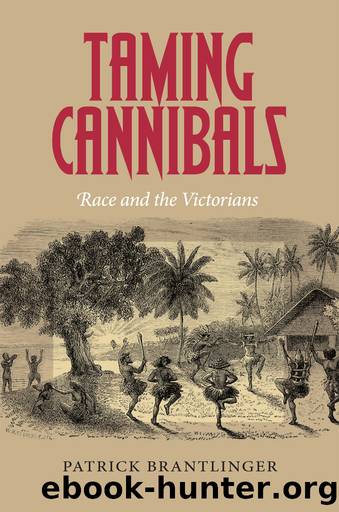Taming Cannibals by Brantlinger Patrick;

Author:Brantlinger, Patrick;
Language: eng
Format: epub
ISBN: 978-0-8014-6264-1
Publisher: Lightning Source Inc. (Tier 3)
Heft versus No Heft
In his essay on Celtic literature, Arnold writes that the Celtic Gauls “had a rule inflicting a fine on every warrior who, when he appeared on parade, was found to stick out too much in front,—to be corpulent, in short.” Arnold suggests that such a rule must have seemed bizarre to a carnivorous race like the Saxons. But, Arnold asks, “has [the rule] not an audacious, sparkling, immaterial manner with it, which lifts one out of routine, and sets one’s spirits in a glow?” (“On the Study” 348). Arnold’s argument boils down to the “immaterial,” “sentimental,” feminine, and ineffectual Celt versus the material, practical, masculine, and Philistine Saxon. The Celt’s immateriality and comparative weightlessness have reduced his race to near extinction; the Saxon’s “heft” has conquered and tamed all of Britain except for Ireland.
Arnold was not alone in attributing in quite literal terms greater heft to the Anglo-Saxons and less corporeality to the Celts. In Friedrich II, for example, Carlyle had expressed “a strong anti-Saxon bias, treating all Saxons comprehensively as drunkards ‘lumbering about in pot-bellied equanimity’” (Briggs 3), while his standard Irishman was a scrawny ragamuffin. In The English and Their Origin (1866), Luke Owen Pike cites Dr. Robert Knox’s Races of Men (1850), which claims that the Celt “in stature and in weight [is] a race inferior to the Saxon” (Pike 50). A Saturday Review article on archaeology also noted the discovery of the site of “an ancient battle, and when the skeletons were removed from the barrow [in Somersetshire], it was seen that they were evidently of two different races. In one group, indeed, a man of giant stature had fallen in a hand-to-hand fight with two comparative pigmies: a conquering Teuton beside two conquered Britons” (Faverty 27). The “Britons” may or may not have been Celts, but measured against a “conquering Teuton” of “giant stature,” just about anyone of any non-Teutonic race might have seemed a “comparative pigmy.” Pike, however, debunks the idea that the Celts were small and the Teutons or Anglo-Saxons strapping. He even rejects others’ physiological and philological arguments that the English were a Teutonic people—they were as much Celtic or Cymric as anything else—only to argue that the contemporary English, via the Cymric connection, were very similar to the ancient Greeks, especially in “energy” and other positive mental and emotional characteristics. Pike’s argument seems to have had little influence. In any event, in Britain, he contended, the Celts and the English were already unified, and this single race could trace its roots and its virtues back to the ancient Greeks.
Arnold wanted the English to be more Greek in cultural terms—to “Hellenize” more and “Hebraize” less—though for him these were also racial terms. Whether or not he was aware of Pike’s work, he also argued that the Saxon was more of a racially mixed-up fellow than the Saxon knew—a bit Celtic as well as Hebraic and Hellenic. And if the hefty Saxon could only get to know the immaterial Celt
Download
This site does not store any files on its server. We only index and link to content provided by other sites. Please contact the content providers to delete copyright contents if any and email us, we'll remove relevant links or contents immediately.
| General | Discrimination & Racism |
Nudge - Improving Decisions about Health, Wealth, and Happiness by Thaler Sunstein(6633)
iGen by Jean M. Twenge(4702)
The Fire Next Time by James Baldwin(4342)
Adulting by Kelly Williams Brown(3669)
The Sports Rules Book by Human Kinetics(3588)
The Hacking of the American Mind by Robert H. Lustig(3580)
The Ethical Slut by Janet W. Hardy(3502)
Captivate by Vanessa Van Edwards(3296)
Mummy Knew by Lisa James(3166)
In a Sunburned Country by Bill Bryson(2946)
Ants Among Elephants by Sujatha Gidla(2924)
The Worm at the Core by Sheldon Solomon(2917)
Suicide: A Study in Sociology by Emile Durkheim(2609)
The Slow Fix: Solve Problems, Work Smarter, and Live Better In a World Addicted to Speed by Carl Honore(2574)
Humans of New York by Brandon Stanton(2379)
Handbook of Forensic Sociology and Psychology by Stephen J. Morewitz & Mark L. Goldstein(2376)
Blackwell Companion to Sociology, The by Judith R. Blau(2318)
The Happy Hooker by Xaviera Hollander(2274)
Outliers by Malcolm Gladwell(2257)
